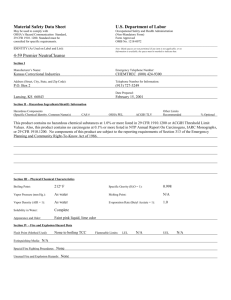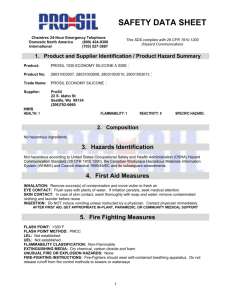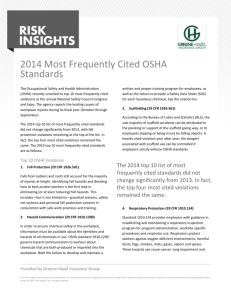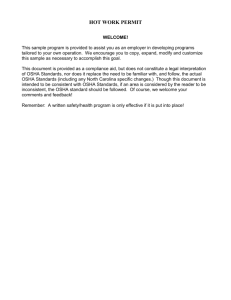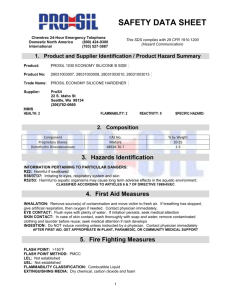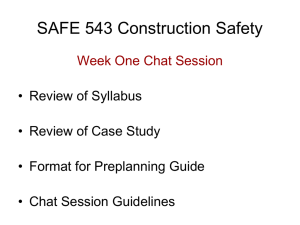a Course Syllabus - Western OSHA Education Center
advertisement
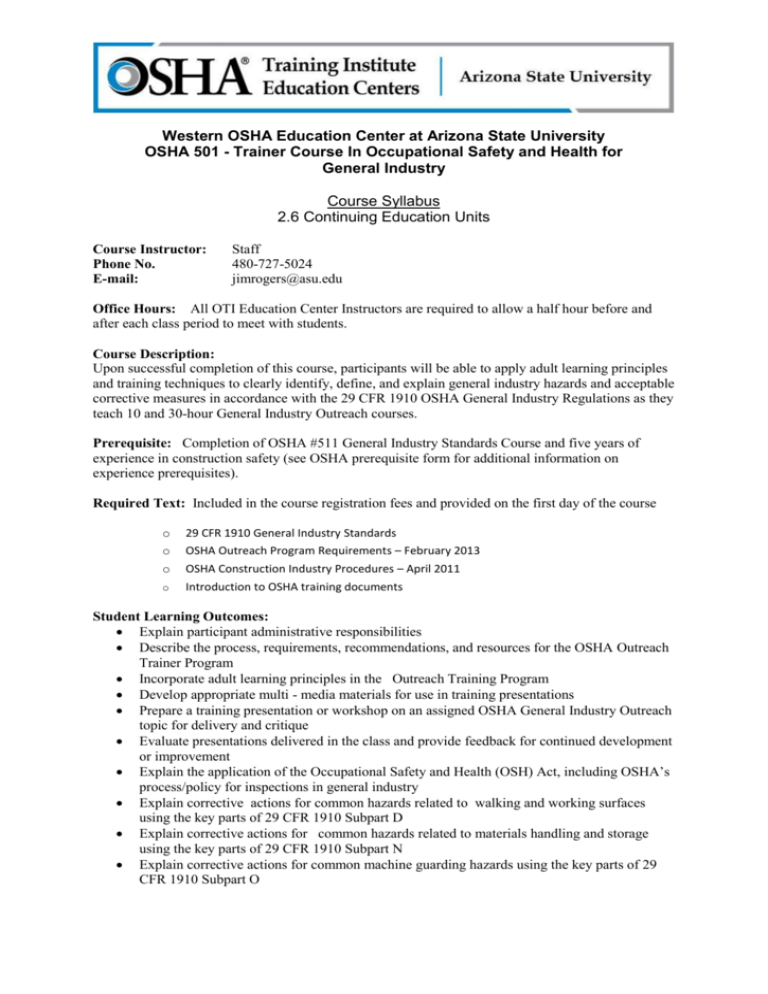
Western OSHA Education Center at Arizona State University OSHA 501 - Trainer Course In Occupational Safety and Health for General Industry Course Syllabus 2.6 Continuing Education Units Course Instructor: Phone No. E-mail: Staff 480-727-5024 jimrogers@asu.edu Office Hours: All OTI Education Center Instructors are required to allow a half hour before and after each class period to meet with students. Course Description: Upon successful completion of this course, participants will be able to apply adult learning principles and training techniques to clearly identify, define, and explain general industry hazards and acceptable corrective measures in accordance with the 29 CFR 1910 OSHA General Industry Regulations as they teach 10 and 30-hour General Industry Outreach courses. Prerequisite: Completion of OSHA #511 General Industry Standards Course and five years of experience in construction safety (see OSHA prerequisite form for additional information on experience prerequisites). Required Text: Included in the course registration fees and provided on the first day of the course o 29 CFR 1910 General Industry Standards o OSHA Outreach Program Requirements – February 2013 o OSHA Construction Industry Procedures – April 2011 o Introduction to OSHA training documents Student Learning Outcomes: Explain participant administrative responsibilities Describe the process, requirements, recommendations, and resources for the OSHA Outreach Trainer Program Incorporate adult learning principles in the Outreach Training Program Develop appropriate multi - media materials for use in training presentations Prepare a training presentation or workshop on an assigned OSHA General Industry Outreach topic for delivery and critique Evaluate presentations delivered in the class and provide feedback for continued development or improvement Explain the application of the Occupational Safety and Health (OSH) Act, including OSHA’s process/policy for inspections in general industry Explain corrective actions for common hazards related to walking and working surfaces using the key parts of 29 CFR 1910 Subpart D Explain corrective actions for common hazards related to materials handling and storage using the key parts of 29 CFR 1910 Subpart N Explain corrective actions for common machine guarding hazards using the key parts of 29 CFR 1910 Subpart O Explain lockout/tagout requirements associated with the hazards of uncontrolled hazardous energy using the key parts of 29 CFR 1910.147 Explain requirements of respiratory protection programs using the key parts of 29 CFR 1910.134 Explain corrective actions for common hazards associated with hazardous materials using the key parts of 29 CFR 1910 Subpart H Explain requirements for entry into and working around permit- required confined spaces using the key parts of 29 CFR 1910.146 Explain corrective actions for common health hazards using the key parts of 29 CFR 1910 Subparts G and Z Explain corrective actions for common electrical hazards using the key parts of 29 CFR 1910 Subpart S Describe the OSHA and ANSI guidelines for safety and health programs Summarize the OSHA recordkeeping requirements Describe the requirements for Personal Protective Equipment (PPE) Explain corrective actions for common hazards associated with emergency preparedness (i.e., means of egress) using key parts of 29 CFR 1910 Subpart E Explain requirements related to fire hazards using the key parts of 29 CFR 1910 Subpart L Explain corrective actions for common hazards associated with hand and portable power ed tools using the key parts of 29 CFR 1910 Subpart P Explain corrective actions for common hazards associated with welding, cutting, and brazing using the key parts of 29 CFR 1910 Subpart Q Explain key requirements of the Hazard Communication Standard Discuss matters concerning OSHA regulations, policies, and practices with a representative from OSHA. (Optional - TBD) Complete the course examination, evaluation, and closing activities. Assessments and Evaluation of Student Performance: A student’s performance will be assessed based on the 100% attendance requirement and a written and performance exam given at the end of the course. The written exam is a closed book knowledge based exam consisting of 50 multiple choice questions. A passing score is 80% or higher. The performance exam is an evaluation of a student’s technical knowledge and their ability to successfully present an instructional module related to construction safety and health at the end of this course. The presentation should be 20 to 30 minutes in length and will be conducted on a topic assigned by the course instructor. Time will be given during class for each student to prepare and present their assigned topic. Note that prep time in class is limited and students may be required to work on their presentation outside of class time. All testing is done in accordance with the OSHA Training Institute Education Center Test Administration Policy issued by the Directorate of Training. Grading Scale: CEU: Graded on a CR/NC basis Course Policies: Attendance Policy: Students are expected to attend all class sessions and to be in class on time. No absences are allowed. Ethics: Each student has an obligation to act with honesty and integrity, and to respect the rights of others in carrying out all academic assignments. You are responsible to learn how the Student Academic Integrity Policy (http://provost.asu.edu/academicintegrity) applies to you personally and to this course in particular. Violations of the University Academic Integrity policy will not be ignored. Penalties include reduced or no credit for submitted work, a failing grade in the class, a note on your official transcript that shows you were punished for cheating, suspension, expulsion and revocation of already awarded degrees. In terms of defining specific examples of cheating, the university policy is very simple. Everything is forbidden until the instructor authorizes it. Cheating is doing something that affects an academic evaluation without the instructor's authorization. We will discuss in class what is authorized and that if you want to do anything else, you need to ask the instructor first. Course Standards a. Prior to the start of class, please turn off your cell phones, radios, Ipods and other electronic devices, or set to silent mode, to avoid unnecessary classroom disruptions. i. Taking notes electronically is permitted as long as the use of the device (computer, tablet, etc.) is restricted to use relating to this class b. There will be no food or drink consumed, or hats worn in classroom. c. Cell phones usage in class is not allowed out of respect to other students. d. Students are responsible for ALL reading assignments and class handouts whether or not the material has been covered in class or specifically listed on the syllabus. e. Students are expected to bring their text, a calculator, writing tablet or notebook, and appropriate writing materials to every class. No sharing of books, calculators, etc. will be allowed during quizzes or tests so please prepare. f. Arizona State University maintains the highest standard for academic honesty and trusts that each student will perform ethically and professionally when preparing required work for this course. Each assignment must represent the student's collective original work, even for work designated as group work. Although ASU encourages collaboration between students, and faculty, in the sharing of ideas and experiences, individual work needs to represent the student's original thought and be distinguishably different from other students work. While discussions between students are encouraged, cheating will not be tolerated. Any student found cheating on an exam, a quiz, or assignment may be given a failing grade for the course and flagrant violations can result in additional consequences. You are cheating if you represent someone else's work as your own or if someone else represents your work as theirs. All graded work (exams, homework assignments, as well as any written exercises or quizzes) in this class must represent your own individual work only. Students may discuss the conceptual aspects of an assignment, but students must turn in their own, independently developed solutions. Grading will include comparing the structure and content of your solution with that of other students. By registration in this class, you are assumed to have read, understand and agreed to this policy, as well as to the procedures conveyed at the web sites below. ABOR Student Code of Conduct and Student Disciplinary Procedures http://students.asu.edu/srr/code ASU Academic Integrity Policy: http://provost.asu.edu/academicintegrity Course Evaluations: Course evaluations and program surveys are important components of the educational process. Students in this course will complete course evaluation forms distributed during the last day of the course. Evaluation is anonymous. Statement on Accommodations: Reasonable accommodations are made on an individualized basis. It is the responsibility of persons with disabilities, however, to seek available assistance and make their needs known. The University has designated the Disability Resource Center as the campus coordinating office for the provision and delivery of services and reasonable accommodations that ensure the University's programs, services, and activities are accessible to students with disabilities. The Disability Resource Center is available to assist any student who has a qualified and documented disability. Please contact the Disability Resource Center at 480-965-1234 (Voice) 480-965-9000 (TTY) for additional information. URL: http://www.asu.edu/studentaffairs/ed/drc/ Sample #501 Course Schedule (Subject to Change): Time Day 1 Day 2 Day 3 Day 4 8:00am Opening Remarks Objectives Introductions OSH Act Inspection Procedures Training Techniques Working with Adult Learners Student Presentations and Evaluations Guest Speaker – Requirements for Safety and Health Programs Overview of Wetern Ed Center OSHA Updates Industry Updates New HazComm Walking and Working Surfaces Developing Presentations How to Handle a Class Student Presentations and Evaluations Guest Speaker – Egress and Emergency Preparedness Outreach Training Requirements Machine Guarding Visual Aids Summary Student Presentations and Evaluations Lunch Lunch Lunch Lunch OSHA Outreach Training Procedures Card Requests New Trainer Assistance Trainer Audits Confined Spaces Lock-out / Tag-out Performance Exam Criteria Discussion of Format Presentation Prep Time Student Presentations Final Course Paperwork 12:00 1:00 4:30pm Material Handling and Storage Hazardous Materials Respiratory Protection Certificates and Cards Photos

